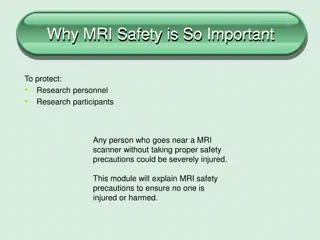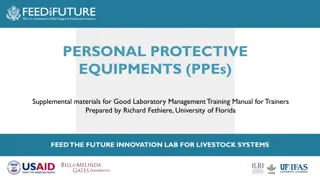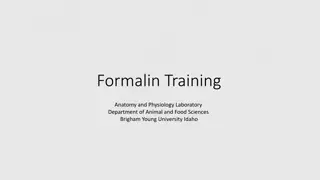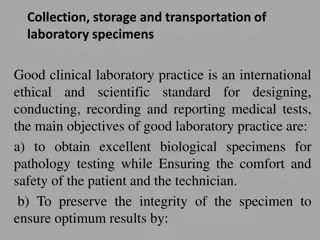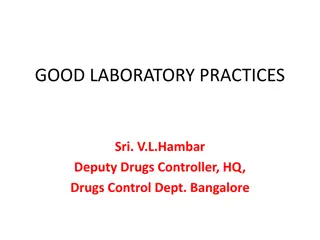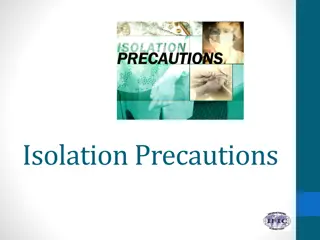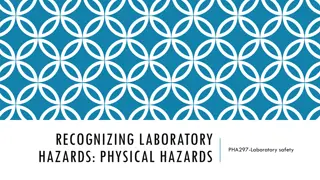Laboratory General Safety and Precautions
Microbiology involves the study of microorganisms such as bacteria, fungi, viruses, and parasites. It is crucial to maintain strict safety protocols in the laboratory to prevent contamination and ensure the well-being of individuals handling these potentially pathogenic organisms. Rules like wearing a laboratory coat, avoiding eating or drinking in the lab, and practicing aseptic techniques are emphasized to mitigate risks. Disregarding safety guidelines may lead to immediate dismissal from the laboratory.
Download Presentation

Please find below an Image/Link to download the presentation.
The content on the website is provided AS IS for your information and personal use only. It may not be sold, licensed, or shared on other websites without obtaining consent from the author. Download presentation by click this link. If you encounter any issues during the download, it is possible that the publisher has removed the file from their server.
E N D
Presentation Transcript
Laboratory 1 General Safety and Precautions
Microbiology is the science that study of microorganisms (MO.), those being unicellular (single cell, like bacteria), multicellular (like fungi), or acellular (lacking cells, like a virus) and including bacteriology, mycology, virology, and parasitology. Bacteria Fungi Microbiology lab. is a place to grow and study tiny organisms, called microorganisms, and these Microbes can include bacteria, fungus, virus , and parasite.
Even if the microorganisms you are studying are not usuallyconsidered pathogenic (disease producing), any culture of anyorganism should be handled as a potential pathogen. Each student must quickly learn and continuously practice aseptic technique. aseptic technique considers important to prevent contamination of your experimental, hand, hair, and clothing with culture material and also to protect your neighbors from any contamination.
Many of the microorganisms used in this course may be pathogenic for humans and animals. As a result, certain rules are necessary to avoid the possibility of infecting yourself or other people. Anyone who chooses to disregard these rules or exhibits carelessness that endangers others may be subject to immediate dismissal from the laboratory. If doubt arises as to the procedure involved in handling infectious material, consult your instructor. Each student is responsible for the observance of the following rules:
1.Place all extra clothing, unnecessary books, purses, backpacks, in an appropriate place. Racks are provided for these materials. The laboratory working area must be kept free of articles not actually in use. 2-Eating, drinking, and smoking are forbidden at all times in the laboratory. 3- Keep your locker or laboratory drawer clean. Do not allow your locker or drawer become filled with cultures that have no value in your current work. 4- Return all reagents, cultures, and glassware to their proper places.
5- Wear a laboratory coat when working in the laboratory. This will protect clothing from contamination or accidental discoloration by staining solutions. 6- Do not place anything in your mouth while in the laboratory. This includes pencils, food, and fingers. Learn to keep your hands away from your mouth and eyes. 7- Avoid contamination of the benches, floor, and wastebaskets. 8- Clean your work area (Laboratory bench) with a phenolic disinfectant such as 50% phenol (or any other disinfectant supplied) before and after each laboratory period. This standard procedure lessens the chance for accidental infection as well as contamination of cultures.
9- Special receptacles will be provided for infectious materials and used glass slides. Place all discarded cultures and contaminated glassware into these receptacles. Do not let unwanted and unneeded materials accumulate. Tall jars filled with a solution such as 5% Lysol or special receptacles will be provided for pipettes. 10- When an infectious material is spilled, cover it immediately with a disinfectant such as 5% Lysol or 5% Phenol and notify your instructor at once.
11- Flame wire loops and needles before and immediately after transfer of cultures. Do not move through the laboratory with a loop or pipette containing infectious material. 12- Wash your hands thoroughly before and after each experiment, using disinfectant soap if possible. 13- Label all experimental material with your; a. Name b. Date c. Exercise number d. Lab section e. Specimen/Organism 14- Long hair should be tied back to minimize fire hazard and contamination of experiments and cultures.
15- Some of the chemicals employed in the various exercises can be hazardous if not handled properly. We have selected experiments to minimize the use of such chemicals; however; where they are necessary, be certain to observe the precautions noted in the exercise and by your instructor. 16- Do not stack Petri plates more than three high on incubator shelves. Tall stacks are a potential hazard if they topple when the incubator is opened. If available, special Petri plate holders (cans) may be used to hold large stacks of plates. 17- To avoid burns, beware of Bunsen burners that will be used in almost every exercise.
18- The Workplace Hazardous Material Information System (WHMIS) requires that all hazardous substances, including microorganisms, be labeled in a specific manner. In addition, there must be a Material Safety Data Sheet (MSDS) available to accompany each hazardous substance. MSDS are now supplied with every chemical sold by supply houses. The person in charge of the microbiology laboratory should ensure that adherence to this law is enforced. 19- Finally, write notes about all the specific safety feature that are located in the laboratory. These would include the fire extinguishers, the safety shower, the fire blanket, the eye wash station, the first aid kit, and emergency exit.
If the instructor does not supply this information, please ask him or her to do so. All laboratory work can be done more effectively and efficiently if the subject matter is understood before coming to the laboratory. To accomplish this, read the experiment several times before the laboratory begins. Know how each exercise is to be done and what principles it is intended to convey.
Much of the work in the laboratory is designed to be carried out in groups or with a partner. This is to aid in coverage of subject matter, to save on time and expense, and to encourage discussion of data and results.
Lab requirements Lab coat Matches or lighter Soap Waterproof permanent marker Small or medium size towel Sealable plastic bag Rubber band General Microbiology Manual
Acquaint yourself with microbiology lab Microscope Dettol Bunsen burner Staining solutions Microscopic slides
oBacterial loop has to be sterilized by flame before and after use.
Microscope Used to view very small objects at a magnification of 40 to 100 times AP0404
Graduated Cylinder: Designed to make accurate volume measurements which are always read from the bottom of the curve (meniscus) Go to fullsize image Go to fullsize image
Beaker beaker Used to hold measure and transport liquids Erlenmeyer Flask Used to approximately measure the volume various liquids. Pyrex Erlenmeyer Flask Starter Pack Useful for mixing by swirling Sizes vary.
Petri Dish Flat disk with a cover used primarily to grow bacteria pfa-petri-dish bacteria_new Bunsen Burner To heat substances
Test Tube Rack Designed to hold test tubes span-urb-a02-cia-124a
Incubator Autoclave Laminar flow Hood
Refrigerator This equipment isused in microbiologylab for storing / preserving cultures, media, and many sensitivematerials
Acquaint yourself with microbiology lab Solid media in tubes Liquid media in tubes Different forms of slants
Blood culture bottles Antibiotic disks





